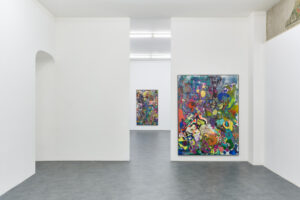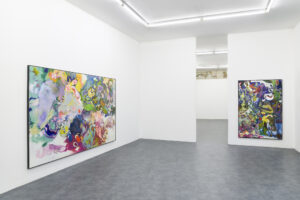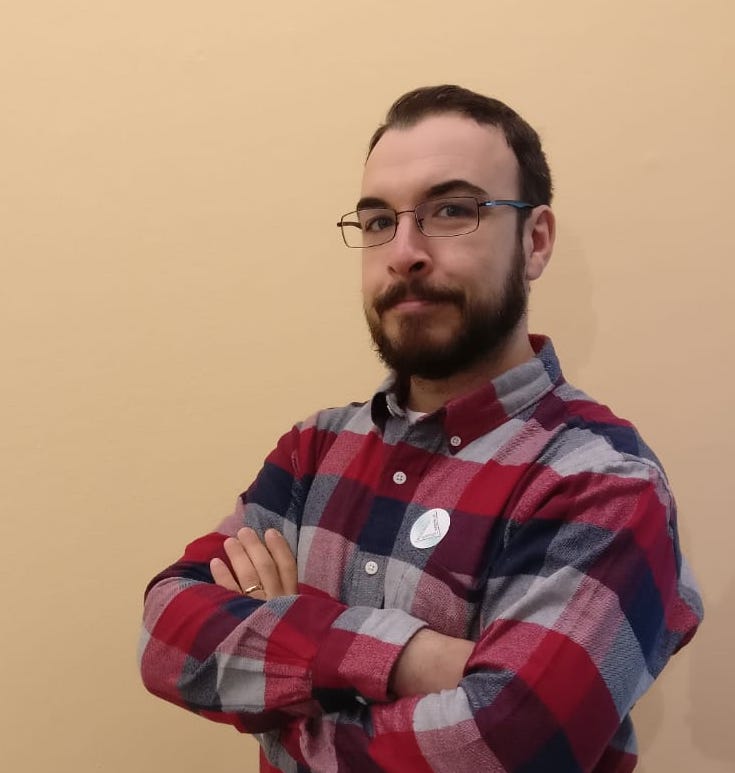Tiziano Martini is an artist I have known since my studies at the Academy in Venice, he already had a very dense and interesting painting at the time, in the most analytical sense of the term. I found it on display at the A+B gallery in Brescia with the one-man show entitled: ANDREAE. I took the opportunity to interview him.

Tiziano Martini, Andreae, exhibition view, A+B Gallery, ph Petrò Gilberti, courtesy A+B gallery
Francesco Liggieri: I would like to make people understand who you are without summarizing it: you can do it by describing yourself with the title of an artwork.
Tiziano Martini: Jonathan Horowitz, Leftover Paint Abstraction #14.
Everything and more has been said about painting. In your opinion, what role does painting have in our society?
An entertaining and evocative function. It’s a sophisticated way to train your eyes and brain, it can generate a variety of suggestions. Painting causes amazement and excites. Persevering in doing it is already intrinsically a strong declaration of intent.

Tiziano Martini, Andreae, exhibition view, A+B Gallery, ph Petrò Gilberti, courtesy A+B gallery
Do you think abstract art has a wider field of research than figurative art?
I think it is a matter of pretexts, which initiate the pictorial act. Consistency in intent and research is fundamental. This becomes crucial if you decide to be influential in a precise direction, or if you want to sharpen your aim, you have to give up something and focus. There are those who use these pretexts (subjects) and those who use others. Let’s think of giants: Rudolf Stingel while was painting his enormous reproductions of passport photos, or Franz Gertsch while in the dark was painting an imposing work which then appears from a distance as a photo. Gertsch has always been categorized as a hyper-realist painter, but neither one nor the other exactly. They are more akin to a marked process than to a figurative one. Same thing could be said of Chuck Close. Perhaps the painting that counts for him disregards the story, and by sublimating it, strikes the same chords in the observer as other more powerful entertainment forms, despite its obvious limitations. Think of a projected video, an installation, or an audio-visual performance: a painting struggles to keep up with their rhythms. And precisely because of these limitations it is a difficult practice, made up of nothing. This allows few to casually generate unedited images that become real sensory experiences. The figure of the champion comes to mind, in aesthetic, athletic, musical, visual terms… he will always leave an indelible mark, due to the innate ease with which things succeed. But we know they are far from easy. From this point of view, when I see a work by Adrian Ghenie I get as excited as when I see a work by Laura Owens.

Tiziano Martini, Andreae, exhibition view, A+B Gallery, ph Petrò Gilberti, courtesy A+B gallery
How has the pandemic affected your work?
It brought it into focus.
When I look at your works I think of the great American abstract artists but not only, what are your pictorial influences?
I take it as a starting point. If we talk about visual suggestions at the moment I feel attracted by authors such as Tomm El-Saieh, Loriel Beltran, Mark Bredford, Eileen Quinlan, Zorawar Sidhu, Mark Flood, Ann Veronica Janssens, Lucy Bull, Seth Price, Adrian Schiess, Anke Weyer, Cory Archangel and others. If we talk about less intimate and visceral affinities I should go fishing outside the usual contexts of art.
Is there a place that you identify as the beginning of your journey and your work?
My hometown, a small town in Lower Saxony, where I spent my years up until my adolescence. However, it is a city that has not deeply marked me. To play down the drama and be fussy, I would say that the first experiences of free drawing without any pretext, other than that of the pleasure of doing, in perfect solitude, I experienced as a child in Soltau. Even my pictorial journey started many years ago from visual experiences accumulated in these places. I was clearly not aware that the life of a person who paints was then made up of so much solitude and self-analysis.

Tiziano Martini, Andreae, exhibition view, A+B Gallery, ph Petrò Gilberti, courtesy A+B gallery
In your opinion, what is the current state of health of contemporary art?
It is a segment that remains fascinating for many, and which many people identify with. I can’t answer, but I like to think of contemporary art as a source of crystalline dolomitic water, from which children, adults, the ignorant, enthusiasts, intellectuals, stupid, professionals can draw, but perhaps sometimes it pays the bills of its ostentatious elitism and fails to be widespread as it should. Excluding Cattelan, it would be interesting through surveys to understand if people not belonging to this field know the work of Vezzoli, Golia, Pessoli, Cuoghi, Pivi, Clemente, Favaretto, Stingel, Bonvicini, and so on. Giancarlo Politi, about ten years ago, argued that in addition to a hundred fundamental successful authors, the rest remains all in the alternative. The message left no room for any misunderstanding.
Have you ever thought about using the digital medium?
Painting is the only thing I’m really interested in working on. It’s part of me. I just want to highlight my ideas and my questions in it.

Tiziano Martini, Andreae, exhibition view, A+B Gallery, ph Petrò Gilberti, courtesy A+B gallery
How is your work usually born?
It is always the result of a generative process which automatically places me in a subordinate position. Often the works are the result of inverse procedures, errors, collisions, which make things intriguing for me and lead me to always continue. I light the fuse, pour boiling water over the tea bag, then see what happens: it seems simplistic, but I can’t do more! If not take the mistake to the extreme. The importance of a method, which is ultimately totally bizarre and obsolete, is not to be understood as a shortcut to the result, but as a release from the concept of it. These methodologies interrupt the intentional/executive continuity and lead me to unconditionally accept the derived images. Relieving me of judgement. I take note of them without necessarily having to accept them. Thus, the single work becomes propaganda material for an entire cycle of complex and articulated work which manifests a clear approach towards the medium. While my role as worker ant can only be a logical consequence.

Tiziano Martini, Andreae, two-component polyurethane varnish, transparent high-solid on mdf, 188×293 cm, 2023, ph Petrò Gilberti, courtesy A+B gallery
As an artist what do you think is your duty towards society?
Temporarily avoiding the definition of artist, which I don’t find adequate now, I would summarize mine as a sense of responsibility. In a broader sense, however, when I think of the artist I imagine him free from the logic of commerce. I refer to authors like Meese or Bock. But also Tino Seghal. However, if I think of Beuys, an ultra-charismatic personality who attempted to foist art on politics, I think of the artist in a moral form within society. Even though he was then called a guru, a charlatan, he raised life to art itself. Even this marked shareholder autobiographism has somewhat dissolved in the contemporary. And fortunately the art of Beuys also lives without Beuys I say, like that of many others. But the profession of artist remains for me an anti-ethical practice, not entirely sustainable, which also involves a form of vanity and selfishness. If we think of the works of some ultra-known contemporary authors, they are nothing but colossal amplifications of their ego, which go beyond the functionality and necessity of the work itself. Works that require materials that are difficult to find, processes that use industrial technologies or enamels that are anything but sustainable. Tiring archiving and management of huge spaces. In my own small way, I have to make use of products that have an impact, that generate waste, fumes, dust. I have to do it in absolute selfishness and cynicism.

Tiziano Martini, Andreae, exhibition view, A+B Gallery, ph Petrò Gilberti, courtesy A+B gallery
David Hockney often, in his interviews, reminds you that painting will never die, what do you think?
I wouldn’t pay too much attention to the decline of genres, but rather to how to paint. After all, painting by its nature is an unrepeatable and irreplaceable practice. This intrinsic authenticity is also its elixir.
If you could choose a historical or fictional character to include in one of your works who would you choose and why?
I would choose to go for a walk in the Dolomites with Vittorio Sella in the early twentieth century. Perhaps then something of him would involuntarily enter the works.
Info:
Tiziano Martini. Andreae
25/05/2023 – 9/09/2023
A + B gallery
Corsetto Sant’Agata, 22
www.aplusbgallery.it

Independent artist and curator. Founder of No Title Gallery in 2011. I observe, study, ask questions, take informations and live in contemporary art, a real stimulus for my research.






NO COMMENT